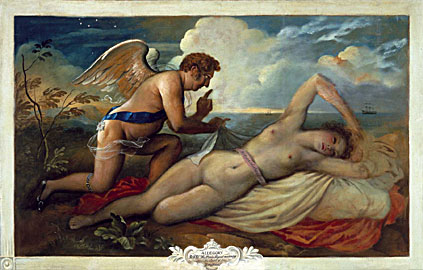In October 1927 Cecil Beaton contrived a photograph of “the bright young things”, as they styled themselves, to which he gave the laconic title On The Bridge, Wilsford. Seven young men and women pose for the camera, all dressed up, in ruffs and frills, patterned silk waistcoats and faux-rustic breeches, as courtly versions of the shepherds and shepherdesses of Arcadia. Beaton himself is there, along with Georgia Sitwell, Zita and “Baby” Jungman, Stephen Tennant, the composer William Walton and the painter-illustrator Rex Whistler. Soon afterwards Osbert Sitwell took the whole group to visit Lytton Strachey at nearby Ham Spray. In characteristically acerbic fashion, Strachey pronounced them “perfectly divine … strange creatures with just a few feathers where brains ought to be.”
Beaton’s photograph is encountered early on in Brighton Museum and Art Gallery’s new exhibition, “Rex Whistler: The Triumph of Fancy”, together with a number of other faded sepia and black-and-white portraits of the artist as a young man – posing theatrically for Beaton among the rocks at Cap Ferrat, clad in nothing but a towel artfully arranged to resemble a loincloth; looking moody in his studio, in four pictures taken by Howard Coster; or – snapped by Beaton again – strumming a guitar in a sylvan scene, like a love-struck Elizabethan courtier in a Nicholas Hilliard miniature. He looks like a charismatic young man, and he certainly impressed most of those with whom he came into contact. Osbert Sitwell went so far as to say – in his Noble Essences or Courteous Revelations, of 1950 – that “To those who knew him the name Rex could signify only one person: a young man of great and lovable character, and possessed of such various talents in the arts and decoration as in their sum to approach...


